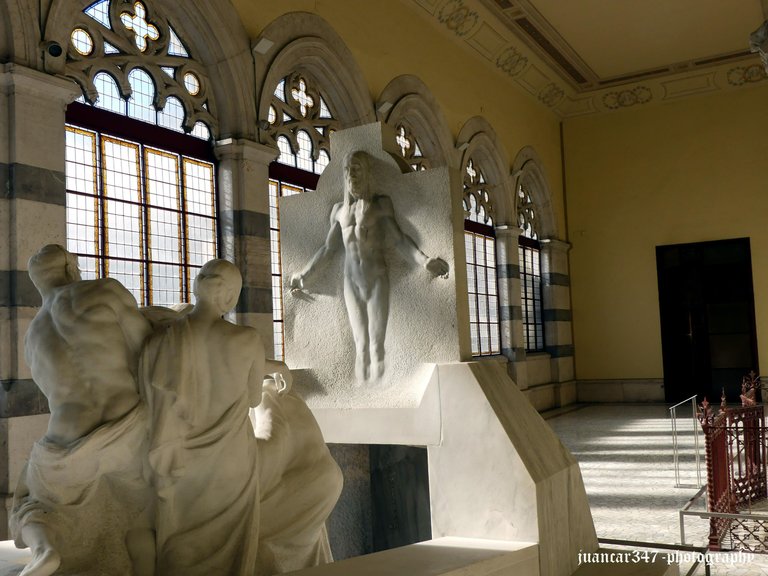
'With its graves, the entire cemetery
It is only a dream, nocturnal and light.
The smoke is nothing but the dream of death,
and, like a log, the fire of life crackles loudly ... ’.
[Hermann Hesse (1)]
[‘Con sus tumbas, el camposanto entero
No es más que un sueño, nocturno y ligero.
El humo no es más que el sueño de la muerte,
y, como un leño, el fuego de la vida crepita fuerte…’.
[Hermann Hesse (1)]
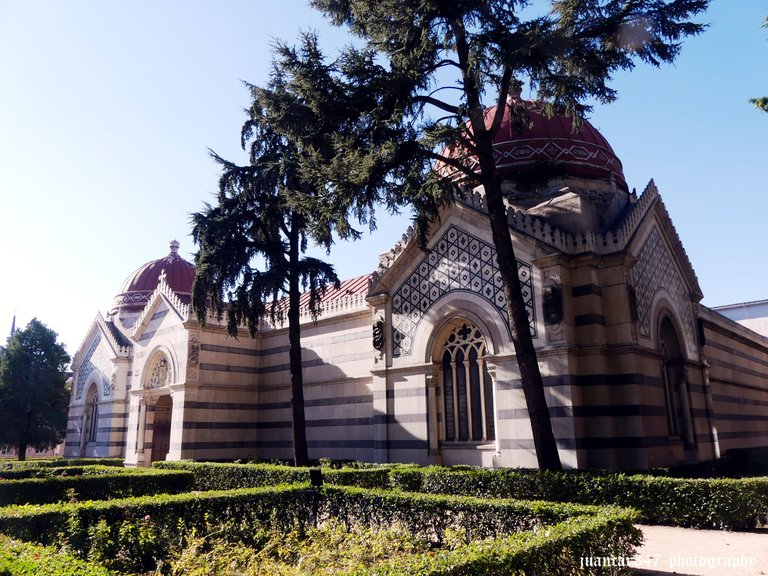
Possibly, both life and death constitute the two faces of the same circumstance, whose details, apparently fleeting, tend to become pious metaphors in the anguished thought of men, to the point of being compared, in an eminently commiserating sense, with dreams.
[Posiblemente, tanto la vida como la muerte, constituyan las dos caras de una misma circunstancia, cuyos pormenores, aparentemente efímeros, tienden a convertirse en piadosas metáforas en el angustiado pensamiento de los hombres, hasta el punto de ser comparadas, en un sentido eminentemente conmiserativo, con los sueños].

Dreams, whether they refer to life or death, have also always had their metaphorical custodians, in the figures of two disciplines, who sympathize, complement and help each other: Art and Architecture.
[Los sueños, tanto si se refieren a la vida como si se refieren a la muerte, también han tenido siempre sus metafóricos custodios, en las figuras de dos disciplinas, que se solidarizan, se complementan y se auxilian entre sí: el Arte y la Arquitectura].
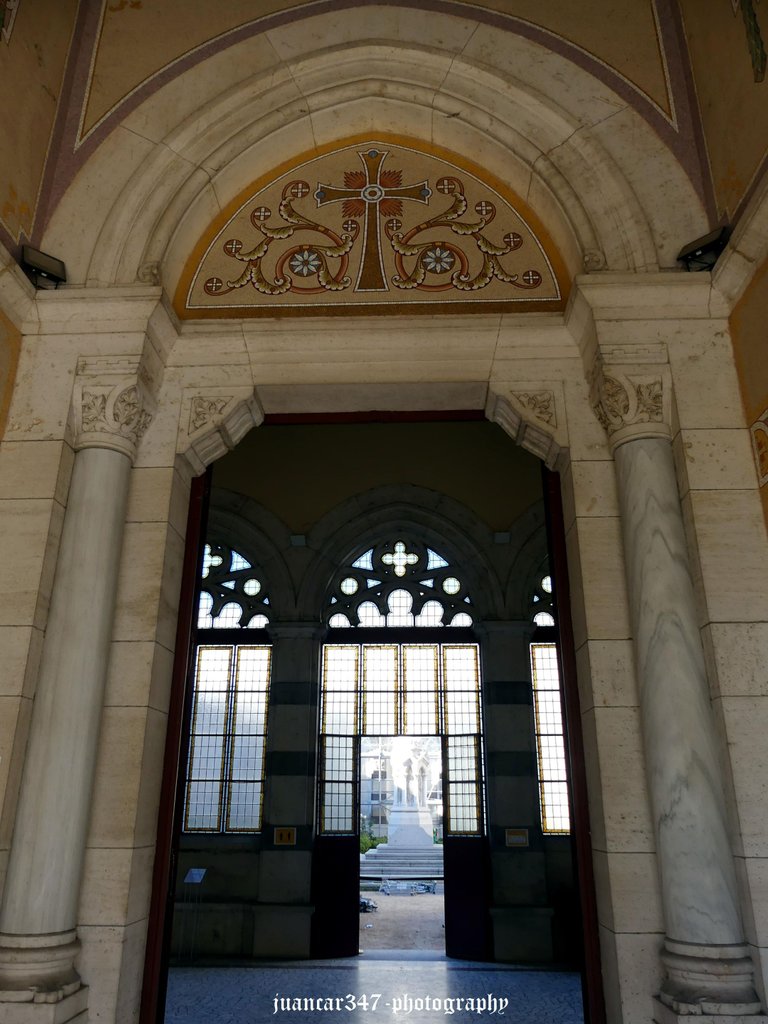
In the same way that both are pleased to surprise us with projects for life, they are also an essential resource in projects for death and it is precisely in one of these projects that I invite you to join me, on this occasion: the Pantheon of Illustrious Men, Madrid.
[De la misma manera que ambas se complacen en sorprendernos con proyectos para la vida, también son un recurso imprescindible en los proyectos para la muerte y es, precisamente, en uno de tales proyectos, donde les invito a acompañarme, en la presente ocasión: el Panteón de Hombres Ilustres, de Madrid].
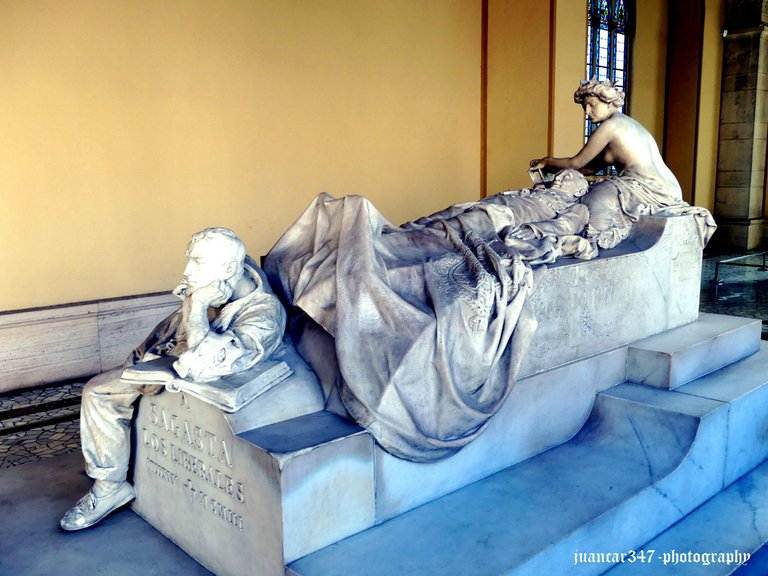
The project of this Madrid architectural landmark took shape at the end of the 19th century, more or less in that comparative Belle Époque, in which great architects and restorers, such as the French Viollet le Duc, achieved, through the perseverance of their artistic demands, that the society of his time would once again look with interest at some architectural styles of the past, taking on special relevance, the Romanesque and Gothic styles, which, after all, constituted a great cultural heritage in the West.
[El proyecto de este hito arquitectónico madrileño, tomó forma a finales del siglo XIX, más o menos en esa comparativa Belle Époque, en la que grandes arquitectos y restauradores, como el francés Viollet le Duc, conseguían, mediante la perseverancia de sus reivindicaciones artísticas, que la sociedad de su época volviera a mirar con interés algunos estilos arquitectónicos del pasado, tomando especial relevancia, los estilos románico y gótico, que al fin y al cabo, constituían una gran herencia cultural en Occidente].
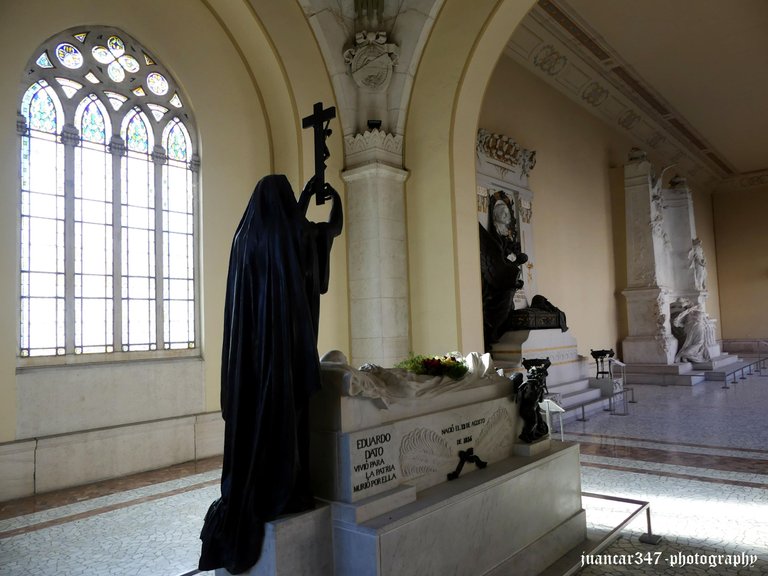
Taking this as a premise, it should not surprise us, at all, that the pertinent proposals submitted to the competition were taken into consideration and the proposal presented by the architect Fernando Arbós y Tremanti was chosen, which consisted of a pseudo-Byzantine basilica - theoretically, the Basilica of Atocha, whose owner, of the same name, is a very popular Black Madonna of Madrid, rising precisely in the place where tradition insists that he performed one of his many miracles, in the person of a nobleman, who He slaughtered his family before they fell into the hands of the Muslim conquerors - a campanile - the spectacular tower, shaped like an obelisk and visible from many points in the Center of Madrid and of course, the Pantheon, whose purpose would be none other than that of serve as a last resting place for the mortal remains of the most granate and at the same time, it could be said that the most unfortunate, of the Spanish politics of the time, since many of the relevant characters in this Pantheon buried, they were assassinated by their political ideas.
[Tomando esto como premisa, no ha de extrañarnos, en absoluto, que presentadas a concurso las pertinentes propuestas, se tomara en consideración y se optara por la propuesta presentada por el arquitecto Fernando Arbós y Tremanti, la cual consistía en una basílica pseudobizantina -teóricamente, la Basílica de Atocha, cuya titular, de igual nombre, es una Virgen Negra muy popular de Madrid, elevándose, precisamente, en el lugar en el que la tradición insiste que realizó uno de sus muchos milagros, en la persona de un noble, que degolló a su familia antes de que cayeran en manos de los conquistadores musulmanes- un campanil -la espectacular torre, con forma de obelisco y visible desde muchos puntos del Centro de Madrid y por supuesto, el Panteón, cuya finalidad no sería otra que la de servir de última morada a los restos mortales de lo más granado y a la vez, podría decirse que lo más desgraciado, de la política española de la época, puesto que muchos de los relevantes personajes en este Panteón sepultados, fueron asesinados por sus ideas políticas].
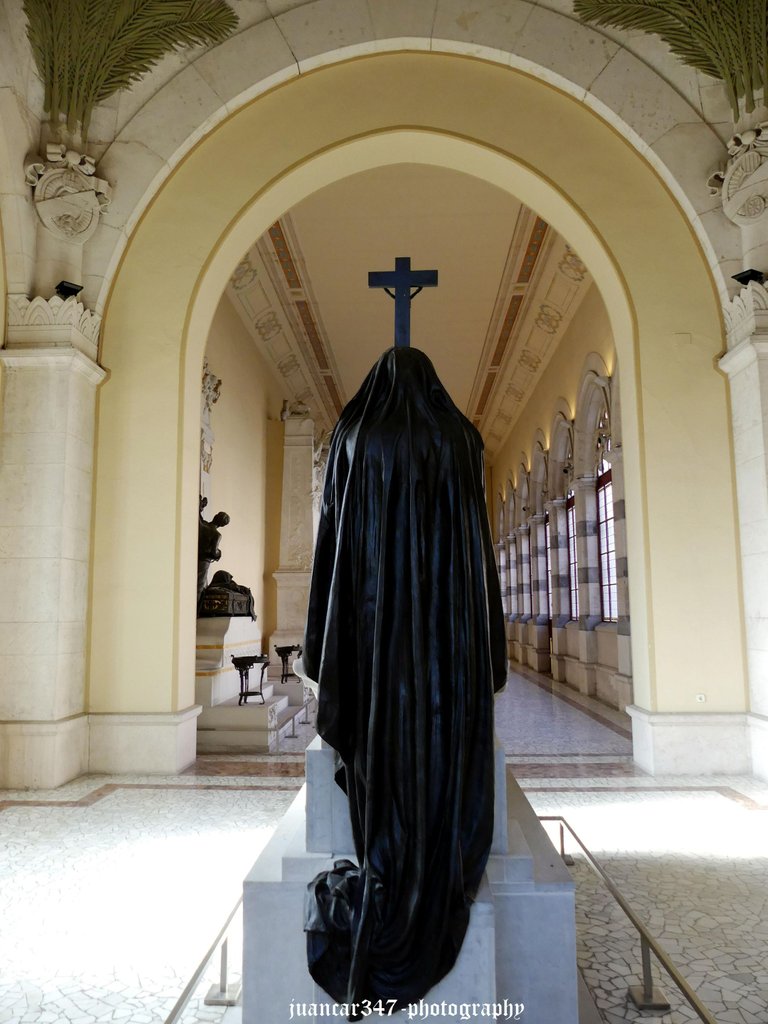
Indeed, inspired by the cemetery of the Piazza del Duomo, in Pisa, Fernando Arbós's project was completed in 1899, taking the shape of a square and cloister-like old Romanesque monasteries-with three galleries decorated with arcades. and stained glass windows -which from my point of view owe much to styles such as Gothic- as well as the showy incorporation of two spherical domes in the corners, the whole set being under the aesthetic patronage of a beautiful garden.
[En efecto, inspirándose en el cementerio de la Plaza del Duomo, de Pisa, el proyecto de Fernando Arbós se terminó de construir en 1899, tomando forma de planta cuadrada y claustral -a semejanza de los antiguos monasterios románicos- con tres galerías decoradas con arcadas y vidrieras -que bajo mi punto de vista, deben mucho a estilos como el gótico- así como la vistosa incorporación de dos cúpulas esféricas en las esquinas, estando todo el conjunto bajo el patrocinio estético de un hermoso jardín].
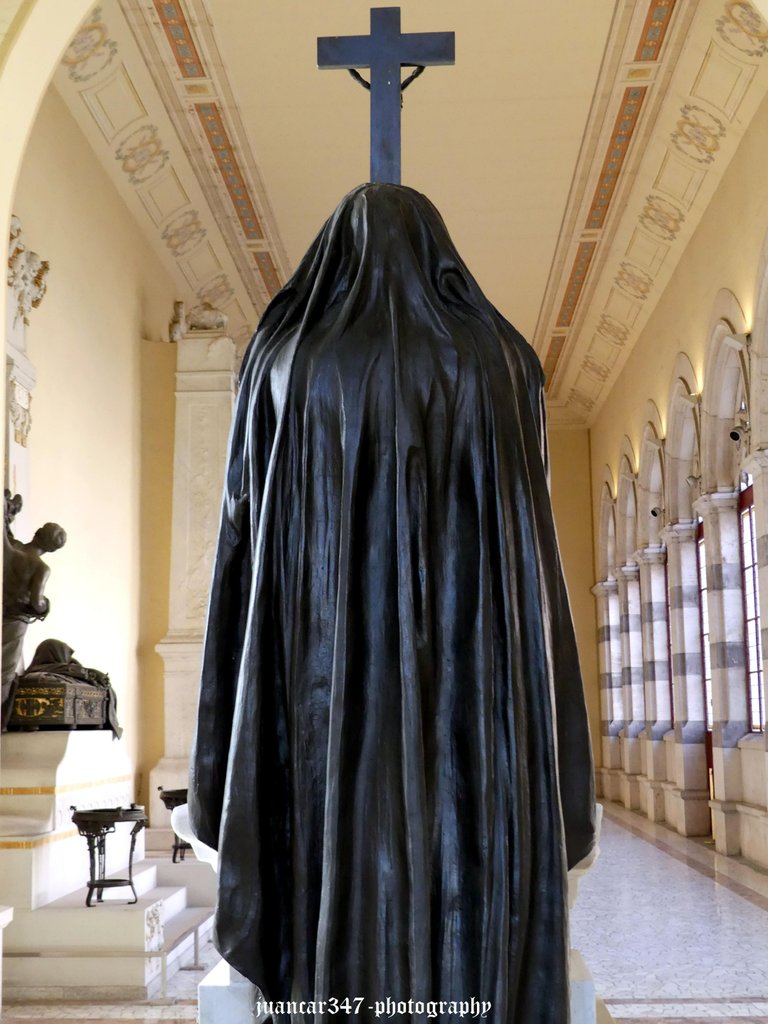
Faced with the elegant austerity of the aforementioned cloister floor, it is worth highlighting, as mentioned before, the presence of the immeasurable works of Art, which constitute, in themselves, the graves distributed along the corridors and which acquire some connotations truly unique, contemplate them through the filtered luminosity that filters through the stained glass windows.
[Frente a la elegante austeridad de la mencionada planta claustral, caben destacar, como se ha comentado antes, la presencia de las inconmensurables obras de Arte, que constituyen, en sí mismas, las sepulturas distribuidas a la largo de los pasillos y que adquieren unas connotaciones verdaderamente singulares, contemplarlas a través de la tamizada luminosidad que se filtra a través de las vidrieras].
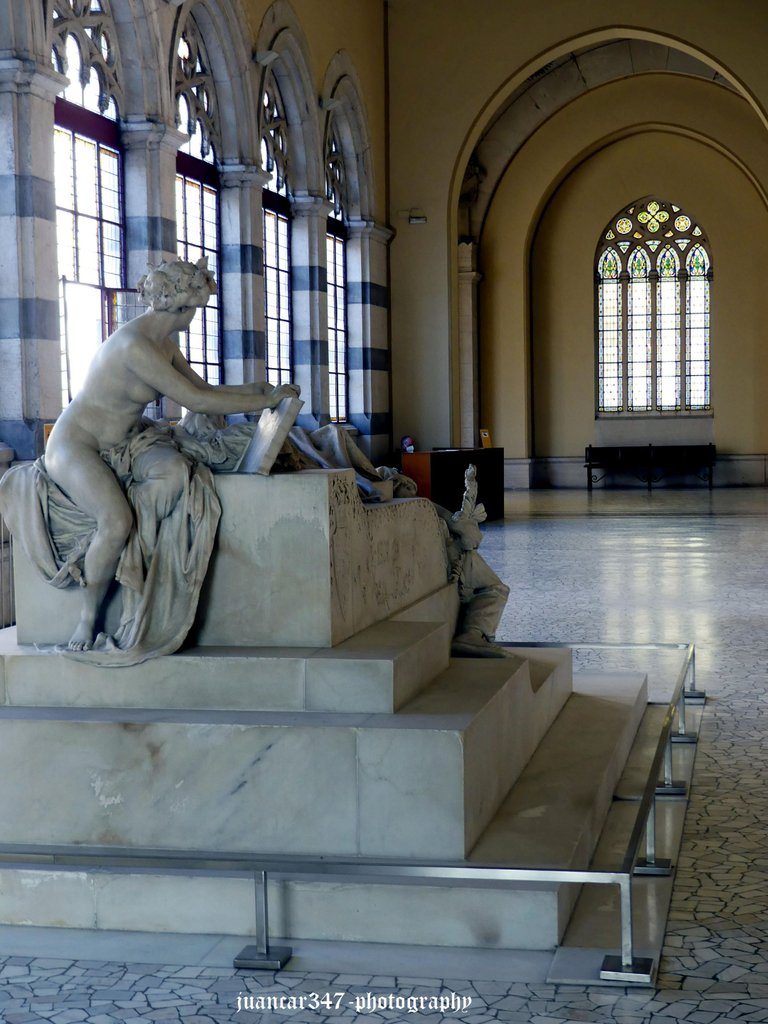
Among these, it is worth highlighting the last and spectacular dwellings of men in the history and politics of Spain, works by true artists of the time, such as Mariano Benlliure, who made the monumental burial of the liberal Práxedes Mateo Sagasta or the also work of Mariano Benlliure, which houses the remains of the conservative politician Eduardo Dato and Iradier, in which a woman in mourning or perhaps a representation of the Angel of Death, raises a cross to the heavens above a representation, also in marble, of the murdered politician, with his hands crossed on his chest.
[Cabe destacar, entre éstas, las últimas y espectaculares moradas de hombres de la historia y la política de España, obras de verdaderos artistas de la época, como Mariano Benlliure, que realizó la monumental sepultura del liberal Práxedes Mateo Sagasta o la también obra de Mariano Benlliure, que acoge los restos del político conservador Eduardo Dato e Iradier, en la que una mujer enlutada o quizás una representación del Ángel de la Muerte, eleva una cruz hacia los cielos por encima de una representación, también en mármol, del político asesinado, con las manos cruzadas sobre el pecho].

Together with these fantastic sculptures, where there is no lack of symbols that characterized liberal or conservative ideas -basically, what today is known as right and left- it is essential to mention, also, those others, no less spectacular, that safeguard the remains of Antonio de los Ríos y Rosas, Antonio Cánovas del Castillo, José Canalejas and Manuel Gutiérrez de la Concha, Marquis del Duero.
[Junta a estas fantásticas esculturas, donde no faltan los símbolos que caracterizaban las ideas liberales o conservadoras -básicamente, lo que hoy se conoce como derechas e izquierdas- es imprescindibles citar, también, aquellas otras, no menos espectaculares, que salvaguardan los restos de Antonio de los Ríos y Rosas, Antonio Cánovas del Castillo, José Canalejas y Manuel Gutiérrez de la Concha, marqués del Duero].
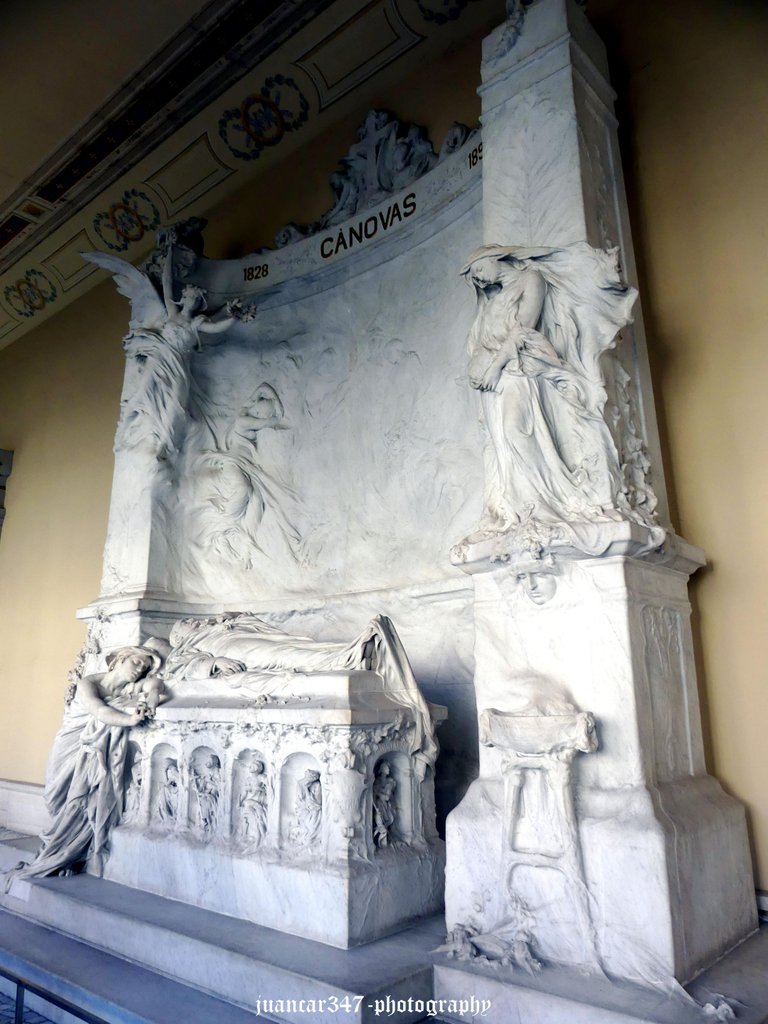
Interesting, on the other hand, is also Benlliure's masterpiece, where the mortal remains of José Canalejas rest and that reproduces a truly shocking allegorical vision of the descent to the tomb of Christ, a figure that awaits the deceased, with open arms, above the gloomy threshold.
[Interesante, por otra parte, es la también obra maestra de Benlliure, donde reposan los restos mortales de José Canalejas y que reproduce una visión alegórica, realmente estremecedora, del descendimiento a la tumba de Cristo, figura que espera al finado, con los brazos abiertos, por encima del tenebroso umbral].
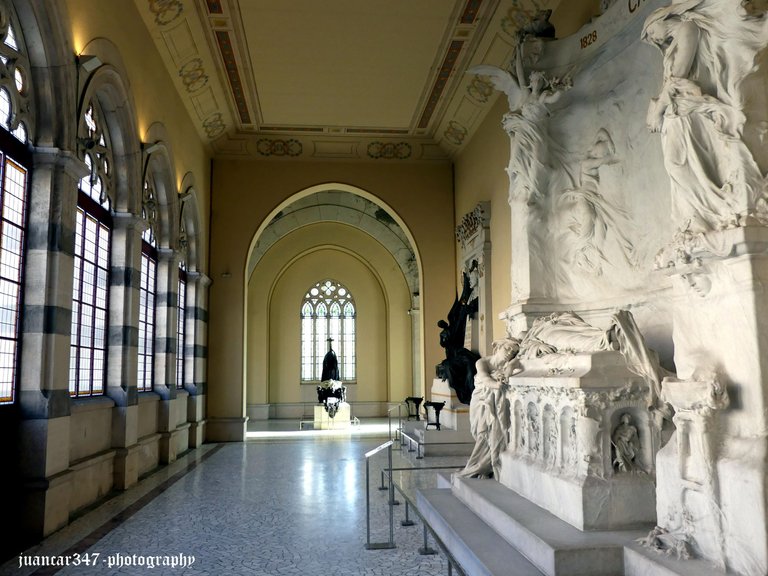
In short: with this Pantheon of Illustrious Men of Madrid, we can have an extraordinary example between the existing affinity between Architecture and Art, but also, considering nature and the cruel way in which its eternal residents came to live in this place, We can also assume that this affinity extends far beyond their respective fields, to teach us a lesson, at least in morality, in which, regardless of what their ideas were, all, in the end, live in the same place, being the most unjust and the most cainite thing in the world, that someone has to pay for his life, in defense of some ideals.
[En definitiva: con este Panteón de Hombres Ilustres de Madrid, podemos tener un extraordinario ejemplo entre la afinidad existente entre Arquitectura y Arte, pero también, vista la naturaleza y la forma tan cruel en la que sus eternos residentes llegaron a morar en este lugar, podemos suponer, también, que esa afinidad se extiende mucho más allá de sus respectivos ámbitos, para darnos una lección, cuando menos de moralidad, en la que, independientemente de cuáles fueran sus ideas, todos, al final, moran en el mismo sitio, siendo lo más injusto y lo más cainita del mundo, que alguien tenga que pagar por su vida, en defensa de unos ideales].
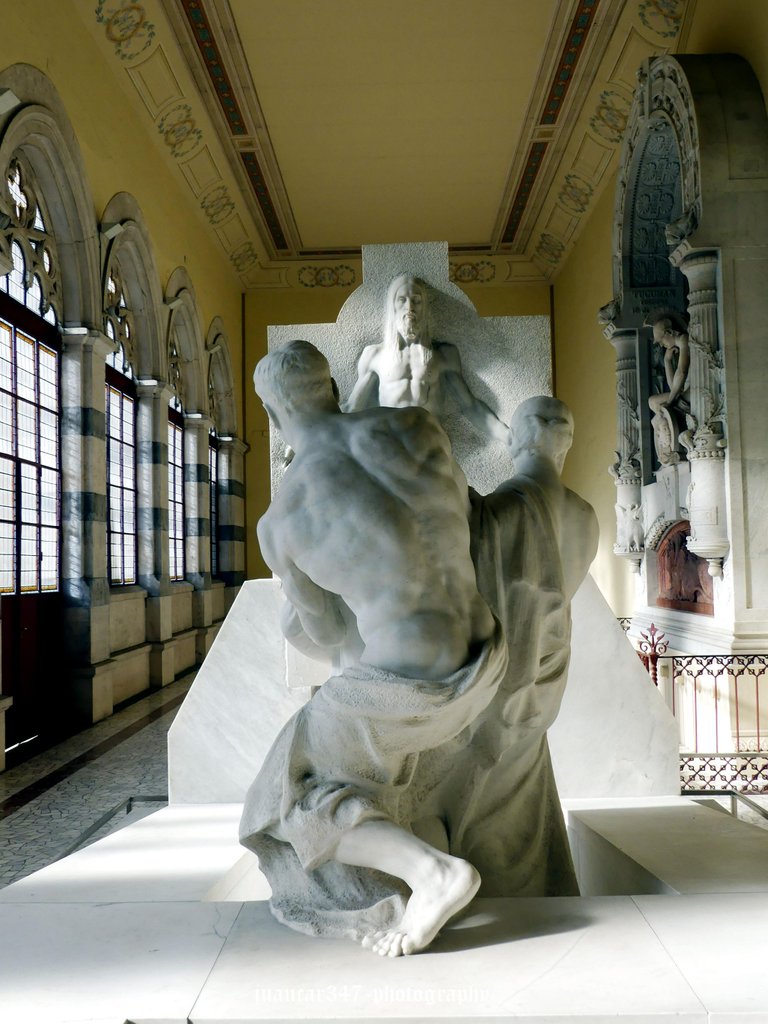
Bibliography and References:
(1) Herman Hesse: ‘El Caminante’, Editorial Bruguera, S.A., 1st edition, Barcelona, March 1978, page 14.
[Bibliografía y Referencias:
(1) Herman Hesse: ‘El Caminante’, Editorial Bruguera, S.A., 1ª edición, Barcelona, marzo de 1978, página 14].
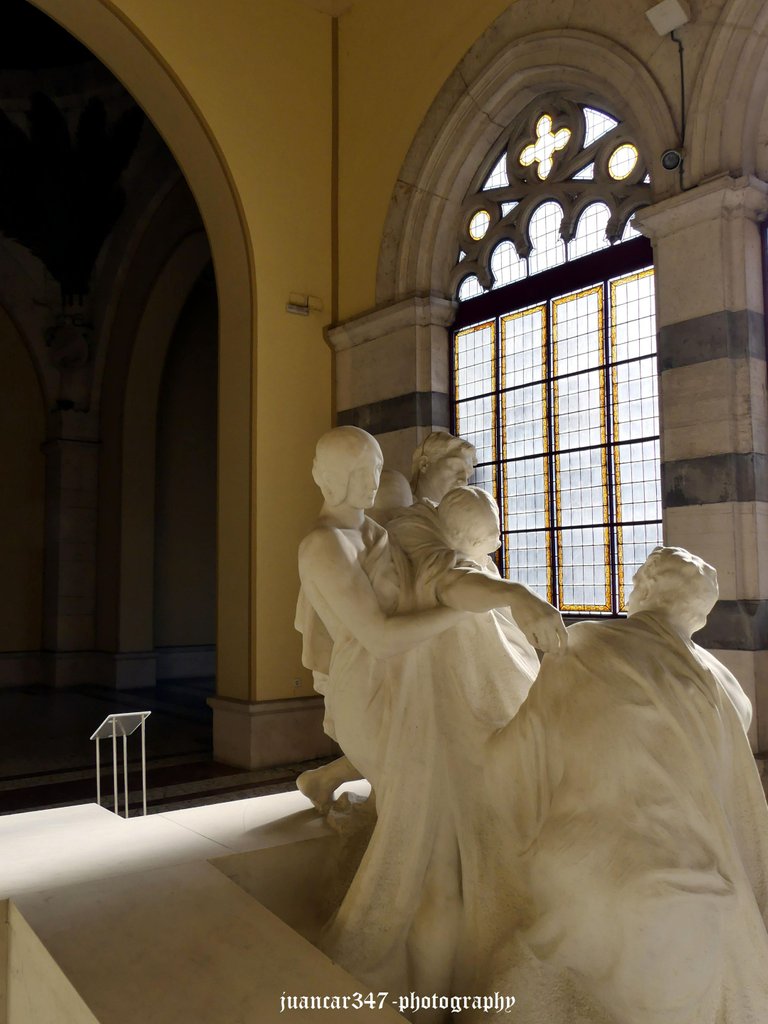
RELATED MOVIE:
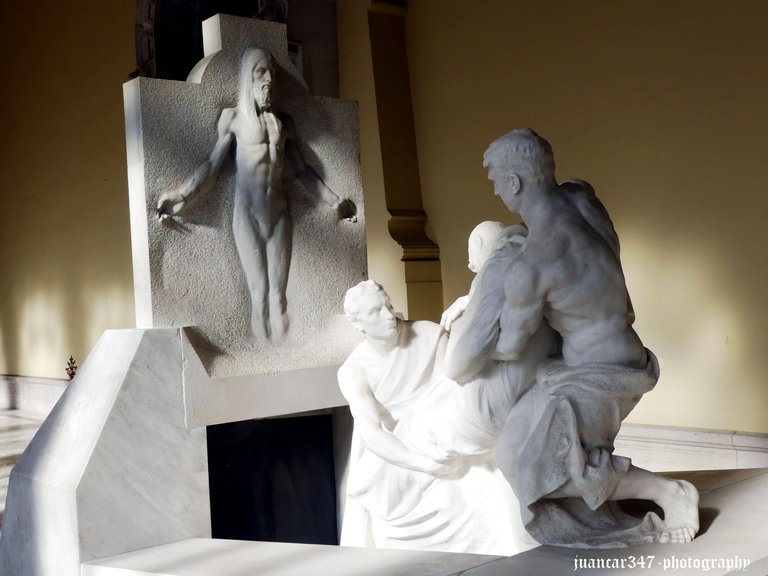
NOTICE: Both the text and the photographs that accompany it, as well as the video that illustrates it, are my exclusive intellectual property and therefore, are subject to my Copyright.
AVISO: Tanto el texto, como las fotografías que lo acompañan, como el vídeo que lo ilustra, son de mi exclusiva propiedad intelectual y por lo tanto, están sujetos a mis Derechos de Autor.
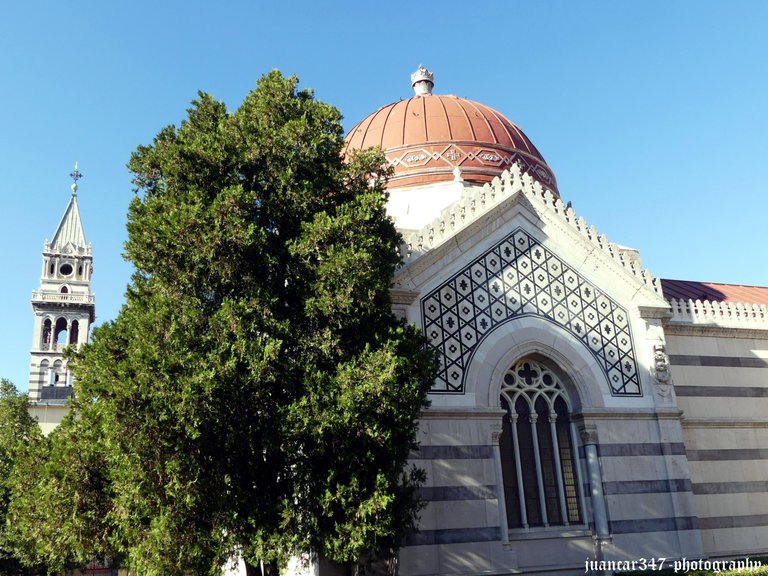
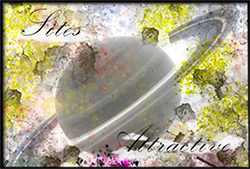



This is the first time that I have seen such artwork, a truly one-of-a-kind symbol of Christianity.
And in a way, it could be said that he is unique, especially for the purpose and content: relevant politicians, believers and non-believers, but who shared the same fate in defense of his ideas. Thank you very much for your comment.
You're welcome (^_^)
The person in black holding cross is just great and frightening. I like this place, like in Italy, a small Pantheon.
I agree: it is a really brilliant and terrifying sculpture at the same time.
Thank you for sharing this amazing post on HIVE!
Your content got selected by our fellow curator @priyanarc & you just received a little thank you via an upvote from our non-profit curation initiative!
You will be featured in one of our recurring curation compilations and on our pinterest boards! Both are aiming to offer you a stage to widen your audience within and outside of the DIY scene of hive.
Join the official DIYHub community on HIVE and show us more of your amazing work and feel free to connect with us and other DIYers via our discord server: https://discord.gg/mY5uCfQ !
If you want to support our goal to motivate other DIY/art/music/homesteading/... creators just delegate to us and earn 100% of your curation rewards!
Stay creative & hive on!
Thank-you very much
Congratulations, your post has been added to Pinmapple! 🎉🥳🍍
Did you know you have your own profile map?
And every post has their own map too!
Want to have your post on the map too?
Thank-you very much
Congratulations @juancar347! You have completed the following achievement on the Hive blockchain and have been rewarded with new badge(s):
You can view your badges on your board and compare yourself to others in the Ranking
If you no longer want to receive notifications, reply to this comment with the word
STOPCheck out the last post from @hivebuzz:
Thank-you very much
De nada @juancar347, es un placer 😊👍 ¡Gracias por su participación de lesiones!
Lovely
Thank-you very much
Wonderful beautiful view of the pictures you just shared. I really wish to visit this place most especially
Thank you. If you ever come to Madrid and like Art and Architecture, I recommend it. Also, it is a good place to meditate and realize how fragile we really are. Greetings
Muchas gracias. Si alguna vez viene a Madrid y le gusta el Arte y la Arquitectura, se lo recomiendo. Además, es un buen lugar para meditar y darnos cuenta, en realidad de lo frágiles que somos. Saludos
Definitely
The Pantheon of Illustrious Men is simply an outstanding expression of architectural and artistic masterpieces that are being influenced by the political powers of those ancient times. Of all the magnificent manifestations of beauty within the interior of that funerary building, the popular Black Madonna of Madrid clearly stands out from the rest. As scary as the statue may seem initially, its contrasting black color signifies our journey through darkness and the internal process of transformation.
Moreover, as tragic as the deaths of those mentioned political figures were, they've become national heroes and found lasting assurance in that solemn resting place where they can continue to exist even during the afterlife, perhaps in the form of dreams - if there's such a thing as an everlasting consciousness. Nevertheless, their crowning legacies will forever remain in the memories of those who dedicated the construction of that sacred landmark for generations to come.
I also cannot be sure of the existence of something beyond physical death, but I do know that Neurobiology has advanced enough to have good prospects in that regard, in view of the latest discoveries about death, the brain and the human cells and here I leave it. Completely in agreement with his appraisals, except for one thing: the black and moving figure that is seen in the grave of the conservative politician, Eduardo Dato, is not a Black Virgin, but rather that the artist, Benlliure, was supposed to represent a woman mourning (instead of the typical mourners that were represented in medieval sarcophagi) although I, out of romanticism, want to go further and see an allegory to the Angel of Death, the Black Angel. The Black Virgin to which I made references, is Our Lady of Atocha, a Romanesque image from the 12th century, which is preserved next to this Pantheon, in the Basilica (also pre-Romanesque) of Atocha, which I intend to show in a future post to complete, in a way this. As always, thank you very much for her comment and her wise contributions. A cordial greeting.
Yo tampoco puedo tener la seguridad de la existencia de algo más allá de la muerte física, pero sí sé que la Neurobiología ha avanzado lo suficiente como tener buenas perspectivas en ese sentido, en vista a los últimos descubrimientos sobre la muerte, el cerebro y las células humanas y aquí lo dejo. Completamente de acuerdo con sus apreciaciones, salvo por una cosa: la figura negra y conmovedora que se ve en la sepultura del político conservador, Eduardo Dato, no es una Virgen Negra, sino que se supone que el artista, Benlliure, quiso representar una mujer de luto (en lugar de las típicas plañideras que se representaban en los sarcófagos medievales) aunque yo, por romanticismo, quiera ir más allá y ver una alegoría al Ángel de la Muerte, el Ángel Negro. La Virgen Negra a la que hacía referencias, es Nuestra Señora de Atocha, imagen románica del siglo XII, que se conserva al lado de este Panteón, en la Basílica (prerrománica también) de Atocha, que pretendo mostrar en un próximo post para completar, en cierto modo este. Como siempre, muchas gracias por su comentario y sus sabias aportaciones. Un cordial saludo.
Oh, I see, many thanks for the correction and for clarifying my confusion. Although it's not the specific Black Virgin of Our Lady of Atocha as you've mentioned, that statue's physical silhouette resembled a dark-colored madonna which I suppose was the reason for my assumption in the first place. Perhaps because of its artistic representation and the way it has been portrayed over the politician's tomb, I came to believe it was the Holy Lady, not an ordinary mourning woman. Happy Tuesday! Excellent post!
It may sound contradictory, but this pantheon is full of life through these spectacular works. Something I've always admired about great artists is their ability to sculpt pieces that convey feelings and actions even though the material they use is static and cold like stone or metal.
*Your post is great @juancar347!
Puede sonar contradictorio, pero este panteón esta lleno de vida a través de estas espectaculares obras. Algo que siempre he admirado de los grandes artista, es su capacidad de esculpir piezas que transmiten sentimientos y acciones a pesar de que el material que usan es estático y frío como la piedra o el metal.
Tu post es genial @juancar347!
You are certainly right. Believe it or not, I have thought about it a lot, it may be because of the wonderful Rodin sculptures in the Thyssen Bornemisza Museum in Madrid, where it seems that they are transformed into flesh, like the famous phrase of Jesus Christ referring to making 'living stones'. It is also true that here the artistic design stands out more than the architectural design itself, which, on the other hand, seems excellent to me, although it does not stop taking advantage of the patterns that became fashionable again at the end of the 19th and early centuries. of the 20th century (neo-Romanesque and neo-Gothic) of which in Madrid there are compliments and interesting examples, of which I will be talking about in subsequent posts. Thank you very much for your comment and kind regards.
Ciertamente no te falta razón. Aunque no lo creas, he pensado mucho en eso, será, quizás, por las maravillosas esculturas de Rodin que hay en el Museo Thyssen Bornemisza, de Madrid, donde parece que se van trasnfigurando en carne, como la famosa frase de Jesucristo referente a hacer 'piedras vivas'. Es cierto, también, que aquí destaca más el diseño artístico que el propio diseño arquitectónico, que por otra parte, me parece excelente, si bien no deja de acojerse a los patrones que se volvieron a poner de moda a finales del siglo XIX y principios del siglo XX (neorrománico y neogótico) de los que en Madrid hay cumplidos e interesantes ejemplos, de los que ya iré hablando en sucesivos post. Muchas gracias por tu comentario y un cordial saludo.
After Rome, a place I will like to visit is Madrid for their creativity
I think Madrid will not disappoint you, although I would like to visit two European cities, which I have always had a special predilection for: Prague and Florence. Thank you very much for your comment.
Well done @juancar347! We're happy to inform you that this publication was specially curated and awarded RUNNER-UP in Architecture Brew #49. Congratulations!
Subscribe to Architecture+Design, an OCD incubated community on the Hive blockchain.
Thank-you very much
With great delight always @juancar347. Keep up the epic posts. 😊
The rewards earned on this comment will go directly to the person sharing the post on Twitter as long as they are registered with @poshtoken. Sign up at https://hiveposh.com.